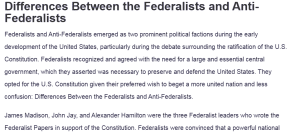Differences Between the Federalists and Anti-Federalists
Federalists and Anti-Federalists emerged as two prominent political factions during the early development of the United States, particularly during the debate surrounding the ratification of the U.S. Constitution. Federalists recognized and agreed with the need for a large and essential central government, which they asserted was necessary to preserve and defend the United States. They opted for the U.S. Constitution given their preferred wish to beget a more united nation and less confusion: Differences Between the Federalists and Anti-Federalists.
James Madison, John Jay, and Alexander Hamilton were the three Federalist leaders who wrote the Federalist Papers in support of the Constitution. Federalists were convinced that a powerful national government would promote economic stability and prevent the nation’s fragmentation into competing interests (Banker, 2024). They thought a nation needed to have a strong central authority to safeguard the rights of the individual and the whole nation.
Conversely, the Anti-Federalists were concerned about a powerful central government, anxious that it might encroach on personal freedoms and the states’ authority. They opposed the Constitution before it was ratified, with no Bill of Rights to protect the people’s liberties and prevent government overreach. Thomas Jefferson, Patrick Henry, and Samuel Adams are among the great leaders of Anti-Federalists. These people thought the new Constitution might lead to the emergence of tyranny similar to the British Monarchy that the colonists had just fought in the Revolutionary War.
The Anti-Federalists also opposed and argued that the central government would be over the states and critically undermine state governments (Barry et al., 2025). They argued that such power must be with the states only and demanded that there must be the inclusion of a list of rights, which would ensure the free exercise of liberties. Because of that they managed to fight and have the Bill of Rights adopted in 1791.
References
Banker, R. (2024). Limitation for liberty: A Commentary on federalism and the tenth amendment. Scholars Crossing. https://digitalcommons.liberty.edu/honors/1455/
Barry, N., Miragliotta, N., Nwokora, Z., & Patapan, H. (Eds.). (2025). Constitutional conventions: Theories, practices and dynamics. Taylor & Francis.
ORDER A PLAGIARISM-FREE PAPER HERE
We’ll write everything from scratch
Question
Week 2 Discussion 2
Required Resources
Read/review the following resources for this activity:
- Textbook: Chapters 7, 8
- Lesson
- Articles of Confederation (1777)Links to an external site. (National Archives, 2023)
- Minimum of 1 scholarly source from the Chamberlain Library resources below:

Differences Between the Federalists and Anti-Federalists
Initial Post Instructions
In preparation for the initial post, consider two (2) issues of the Articles of Confederation and describe the main problems that the United States faced under the Federation government.
Then, in one (1) to two (2) paragraphs, address one (1) of the following:
- Analyze two major debates (see textbook Chapter 7, Section 7.4) by which the Constitution was created in the summer of 1787.
- Discuss the ratification process of the Constitution of 1787.
- How did ratification lead to the formation of America’s first two political parties, the Federalists and Anti-Federalists?
- What were the major differences between the Federalists and Anti-Federalists, and who were the best-known members of each party?

